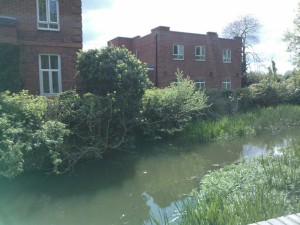Surrey River set to benefit from flood risk and wildlife improvements
 The Abbey River, a backwater of the River Thames in Surrey, is set to benefit from a project which will not only enhance wildlife but also reduce flood risk for the local community.
The Abbey River, a backwater of the River Thames in Surrey, is set to benefit from a project which will not only enhance wildlife but also reduce flood risk for the local community.
The Abbey River Improvement Project is a partnership project between the Environment Agency, the Wild Trout Trust and Thames 21. The project was initially identified by the Environment Agency Fisheries and Biodiversity department to enhance the Abbey River for wildlife and facilitate fish migration. However, the project will also bring about flood risk benefits, which have been modelled and reviewed by the Environment Agency’s Flood and Coastal Risk Management (FCRM) team.
At present there are sluices at the downstream extent of the Abbey River which, in their present condition, cannot be operated. These sluices prevent fish passage and impound or ‘back up’ the river upstream. This impounding effect causes the river to be slow flowing. In turn, this allows the deposition of fine sediment leading to a loss of habitat diversity and a reduction in channel capacity.
Over the last two years the Environment Agency has been consulting with local communities, interested organisations, and groups to develop a project that enhances the wildlife value of the river whilst improving flood risk. Local landowners have received letters and have been invited to face-to-face meetings to speak to Environment Agency staff as the project progresses.
Lizzie Rhymes, Fisheries and Biodiversity Technical Specialist and project lead for the Environment Agency said:
“We plan to improve fish passage between the Abbey River and the River Thames, to enhance the river and create a more natural gradient – encouraging higher flow velocities with a greater ability to ‘self clean’ and remain free of silt.”
Work will be undertaken on the river’s sluices. One of the sluices will be replaced with a fish pass and a facility to insert stop logs to manage river flows and levels.
The second sluice will be replaced by a tilting weir which will provide a flood risk benefit over the existing sluices. Replacing the sluices in this way will lower the water level upstream, increase velocity, and improve the capacity of the river to convey water during periods of high flow. Furthermore the project will enable fish and other wildlife to migrate freely between the Abbey River and the River Thames and will make the channel less suitable for invasive non-native plant species.
Upstream of the sluices the team will create a new fish spawning habitat which is currently missing from much of the Abbey River and River Thames. This will be achieved by dressing the river bed in five locations with a layer of imported gravel to form features known as riffles which help aid spawning opportunities. Our contractors will remove silt before any gravel is placed in the river to ensure that there is no net introduction of material.
Once delivered, the project could result in a 20-30% improvement in the conveyance of water through the Abbey River when it is at full capacity. The full extent of these improvements will not be realised when the River Thames (downstream) is also very high and ‘backed up’. When these conditions are experienced it is the River Thames that dictates conveyance through the Abbey River.
Lizzie Rhymes added:
“Later on in the year we will also be engaging with local communities to work towards tackling floating pennywort on the Abbey River. This non-native species out competes our own native flora and can heighten flood risk. If left unmanaged, it can form dense carpets and reduce flow”.
This entry was posted in
News and tagged
Environment Agency,
Fish,
Fishing,
Flood,
Thames. Bookmark the
permalink.


